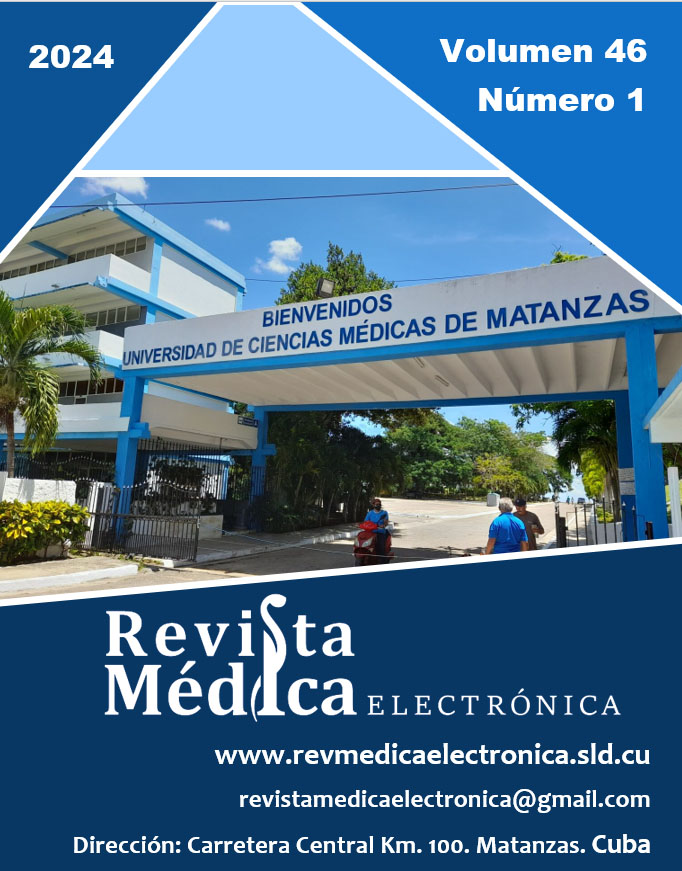Estudio de las trombofilias por el laboratorio clínico
Palabras clave:
trombofilia, laboratorio clínicoResumen
La trombofilia se define como una predisposición individual a padecer episodios tromboembólicos. Debido a la elevada y creciente incidencia tanto mundial como en Cuba de eventos cardiovasculares, cerebrovasculares y vasculares periféricos, cuya patogenia involucra la trombofilia, se hace necesaria una actualización de la utilidad de las pruebas de laboratorio clínico para su estudio. Esta revisión tiene como objetivo actualizar la información sobre la indicación e interpretación de los exámenes de laboratorio clínico útiles en el estudio de las trombofilias. Se realizaron búsquedas en las bases de datos PubMed, SciELO, LILACS y ClinicalKey, con las palabras clave “trombofilia” y “laboratorio clínico”, en inglés y español. La búsqueda reveló 120 artículos, de los cuales 27 fueron novedosos y relevantes para el tema. Se debe investigar el estado trombofílico en cualquier paciente que presente trombosis venosa antes de los 45 años —recurrente o en sitios inusuales—, trombosis neonatal inexplicable, necrosis cutánea por cumarínicos, resistencia a anticoagulantes, trombosis arterial antes de los 30 años, historia familiar trombofílica, pérdida recurrente de embarazos, púrpura trombocitopénica trombótica o lupus eritematoso sistémico. Las investigaciones iniciales serán: hemograma completo, observación de extensión coloreada de sangre periférica y tiempo parcial de tromboplastina activada. Los exámenes más específicos incluirán el estudio genético del factor V Leiden, ensayos para detectar déficits de antitrombina, proteína C o proteína S; análisis del ADN para el alelo G20210A de la protrombina, determinación del factor VIII y de homocisteína, y detección de anticoagulante lúpico, anticuerpos anti-β2-glicoproteína I y anticardiolipina.
Descargas
Citas
2. Gill S, Dhull P, Bhardwaj M. Prevalence of inherited procoagulant states in cerebral venous thrombosis and its correlation with severity and outcome. Neurosci Rural Pract. 2022;13(1):67-72. DOI: 10.1055/s-0041-1741488.
3. Tauqeer Z, Bracha P, McGeehan B, et al. Hypercoagulability testing and hypercoagulable disorders in young central retinal vein occlusion patients. Ophthalmol Retina. 2022;6(1):37-42. DOI: 10.1016/j.oret.2021.03.009.
4. Olivo Freites C, Naymagon L. The utility of hereditary thrombophilia testing among patients with unprovoked venous thromboembolism. Int J Lab Hematol. 2022;44(2):393-8. DOI: 10.1111/ijlh.13752.
5. Lobo JL, Alonso S, Arenas J, et al. Multidisciplinary Consensus for the Management of Pulmonary Thromboembolism. Arch Bronconeumol. 2022;58(3):246-54. DOI: 10.1016/j.arbres.2021.01.031.
6. Xie J, Prats-Uribe A, Feng Q, et al. Clinical and genetic risk factors for acute incident venous thromboembolism in ambulatory patients with COVID-19. JAMA Intern Med. 2022;182(10):1063-70. DOI: 10.1001/jamainternmed.2022.3858.
7. Bustillo-Santandreu MdJ, Álvarez-López Y, Feíto-Castex TR, et al. Morbi-mortalidad de la enfermedad tromboembólica venosa en el Hospital Universitario “Arnaldo Milián Castro”. Rev Cubana Angiol Cir Vasc [Internet]. 2022 [citado 22/12/2022];23(1). Disponible en: https://revangiologia.sld.cu/index.php/ang/article/view/320/333
8. Arachchillage DJ, Mackillop L, Chandratheva A, et al. Thrombophilia testing: A British Society for Haematology guideline. Br J Haematol. 2022;198:443-58. DOI: 10.1111/bjh.18239.
9. López-Sacerio A, Torres-Iribar W, Cruz-Rodríguez J. Enfermedad tromboembólica venosa en hemopatías malignas: un enfoque desde la prevención. Rev Cubana Hematol Immunol Hemoter [Internet]. 2022 [citado 22/12/2022];38(2). Disponible en: https://revhematologia.sld.cu/index.php/hih/article/view/1620
10. Tefferi A, Barbui T. Polycythemia vera and essential thrombocythemia: 2021 update on diagnosis, risk-stratification and management. Am J Hematol. 2020;95(12):1599-613. DOI: 10.1002/ajh.26008.
11. Asakrah S, Davis R, Bhargava P. Practical considerations and testing nuances for the detection of lupus anticoagulant: Do low phospholipid screen results, assay type, and test ratio matter? Am J Clin Pathol. 2021;156(6):1073-82. DOI: 10.1093/ajcp/aqab069.
12. Lee Y, Gu JY, Kim HK. Real-world evidence of lupus anticoagulant testing: simultaneous positivity of diluted Russell's viper venom time and silica clotting time increases thrombotic risk prediction. J Thromb Thrombolysis. 2022;54(2):318-22. DOI: 10.1007/s11239-022-02675-9.
13. Abughanimeh OK, Marar RI, Tahboub M, et al. Hereditary thrombophilia testing among hospitalized patients: Is it warranted? Cureus. 2022;14(5):e24855. DOI: 10.7759/cureus.24855.
14. Takhviji V, Zibara K, Maleki A, et al. A case-control study on factor V Leiden: an independent, gender-dependent risk factor for venous thromboembolism. Thromb J. 2021;19(1):74. DOI: 10.1186/s12959-021-00328-0.
15. Wei Y, He Y, Guo X. Clinical phenotype and genetic analysis of twins with congenital coagulation factor V deficiency. J Pediatr Hematol Oncol. 2022;44(2):e482-6. DOI: 10.1097/MPH.0000000000002261.
16. Ardizzone A, Capra AP, Mondello S, et al. H1299R variant in Factor V and recurrent pregnancy loss: A systematic review and meta-analysis protocol. Genes (Basel). 2022;13(6):1019. DOI: 10.3390/genes13061019.
17. Cepero Llauger K, Pérez Rosales CL, Carnot Uria J, et al. Caracterización de la trombofilia en pacientes con mutación del factor V de Leiden en el Hospital Hermanos Ameijeiras 2011-2021 [Internet]. La Habana: Convención Científica XL Aniversario Hospital Hermanos Ameijeiras; 2022 [citado 22/12/2022]. Disponible en: https://convencionhha.sld.cu/index.php/convxlhha/conv2022/paper/view/199
18. Noiri JI, Matsuzoe H, Nagaya S, et al. A case of venous thromboembolism caused by protein C deficiency due to a novel gene mutation. J Cardiol Cases. 2022;26(5):360-3. DOI: 10.1016/j.jccase.2022.07.012.
19. Brouns SL, Tullemans BM, Bulato C, et al. Protein C or Protein S deficiency associates with paradoxically impaired platelet-dependent thrombus and fibrin formation under flow. Res Pract Thromb Haemost. 2022;6(2):e12678. DOI: 10.1002/rth2.12678.
20. Kashfi S, Farhan Nasser M, Soleiman A, et al. Clot in transit in a patient with protein S deficiency. Eur J Case Rep Intern Med. 2022;9(5). DOI: 10.12890/2022_003355.
21. Zamora González Y, Urrutia Febles Y, Forrellat Barrios M. Trombosis y su relación con la deficiencia de proteínas C y S. Rev Cubana Hematol Inmunol Hemoter [Internet]. 2020 [citado 17/10/2022];36(4):e1175. Disponible en: http://scielo.sld.cu/scielo.php?script=sci_arttext&pid=S0864-02892020000400009
22. Kruijt M, Van der Pol LM, Eikenboom J, et al. Unraveling a borderline antithrombin deficiency case with quantitative mass spectrometry. J Thromb Haemost. 2022;20(1):145-8. DOI: 10.1111/jth.15553.
23. Raptopoulou A, Michou V, Mourtzi N, et al. Large-scale screening for factor V Leiden (G1691A), prothrombin (G20210A), and MTHFR (C677T) mutations in Greek population. Health Sci Rep. 2022;5(4):e457. DOI: 10.1002/hsr2.457.
24. Liu A, Phair J, Naymagon L. Utility of hereditary thrombophilia testing among patients with lower extremity deep vein thrombosis. J Vasc Surg Venous Lymphat Disord. 2022;10(4):841-5. DOI: 10.1016/j.jvsv.2022.02.019.
25. Khalife S, Geitani R. Association of inherited thrombophilia with recurrent pregnancy loss in a population of Lebanese women: A Case Control Study. Int J Fertil Steril. 2022;16(3):247-51. DOI: 10.22074/IJFS.2022.540950.1205.
26. Tamayo-Velasco A, Cebeira MJ, Bombín-Canal C, et al. Fibrinogen deficiency with thrombotic manifestations. Eur J Case Rep Intern Med. 2022;9(6). DOI: 10.12890/2022_003400.
27. Deloughery TG, Hunt BJ, Barnes GD, et al. WTD Steering Committee. A call to action: MTHFR polymorphisms should not be a part of inherited thrombophilia testing. Res Pract Thromb Haemost. 2022;6(4):e12739. DOI: 10.1002/rth2.12739.
Publicado
Cómo citar
Número
Sección
Licencia
La misma permite:
• Copiar y redistribuir el material publicado en cualquier medio o formato.
• Adaptar el contenido.
Esto se realizará bajo los siguientes términos:
• Atribuir los créditos de los autores e indicar si se realizaron cambios, en cuyo caso debe ser de forma razonable.
• Uso no comercial.
• Reconocer la revista donde se publica.
Se mantienen los derechos de autoría de cada artículo, sin restricciones.







